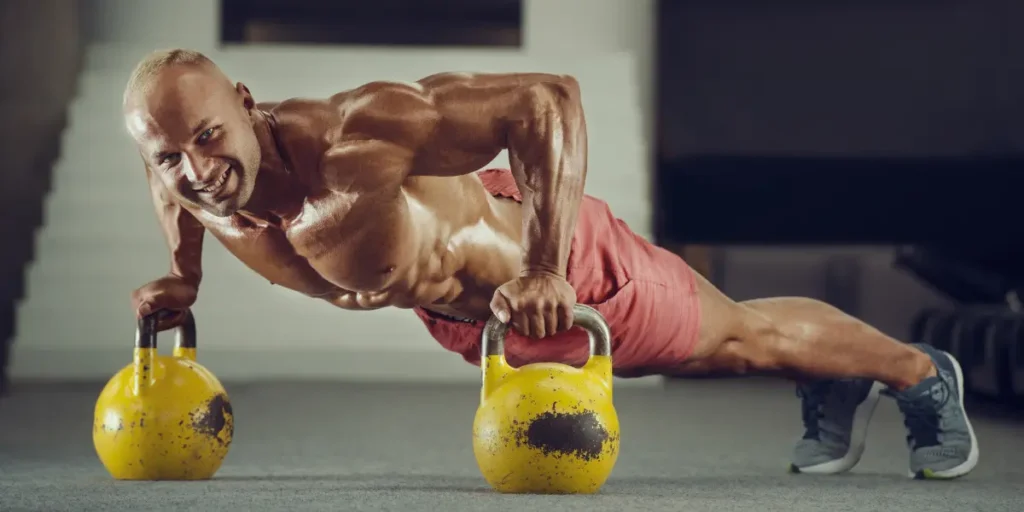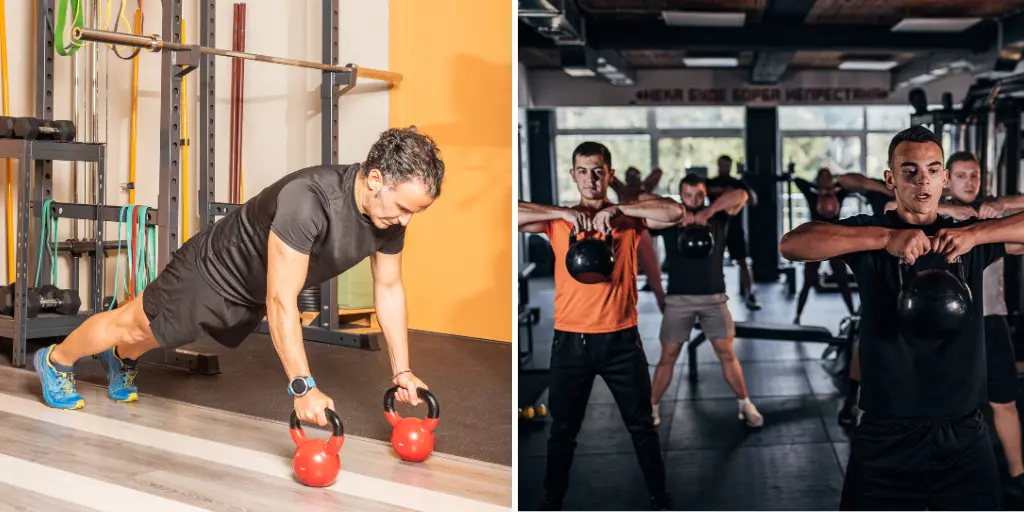Transform Your Strength with This Powerful Kettlebell Chest Workout
Every fitness journey starts with a spark of transformation. I remember the day I discovered kettlebell workouts for chest development. It was a game-changer that changed my strength training forever.
Kettlebells offer a unique muscle-building experience. They challenge your body in ways you never imagined. Unlike traditional weights, kettlebells provide a dynamic approach to muscle development.
Kettlebell chest workouts aren’t just another routine. They offer greater range of motion and intensity. You’ll unlock muscle growth, enhanced core stability, and full-body engagement that traditional exercises can’t match.
Whether you’re a beginner or an experienced athlete, kettlebell chest workouts can be tailored to your fitness level. These versatile tools allow you to create challenging routines. They target your chest muscles while improving overall strength and cardiovascular endurance.
Table of Contents
Benefits of Kettlebell Workouts for Chest Development
Kettlebell workouts are a unique way to build your chest muscles. They offer more than just weight training. These exercises engage your muscles fully and build functional strength.
Adding kettlebell chest exercises to your routine brings many benefits:
Improved Strength and Muscle Tone
Kettlebell training is great for chest muscle growth. It uses different movements than dumbbells or barbells. This challenges your muscles in new ways.
- Targets pectoral muscles with complete muscle activation
- Improves muscle definition with varied exercises
- Increases muscle size with 10-12 reps per set
Enhanced Core Stability
Kettlebell exercises require strong core muscles during chest workouts. You’re not just working your chest. You’re also strengthening your core.
“Kettlebell training transforms your workout from isolated muscle training to full-body functional strength development.”
Increased Range of Motion
Kettlebell movements are dynamic, allowing for better joint mobility. These exercises help improve shoulder and chest flexibility. They also lower injury risks.
- Maximizes muscle fiber activation
- Improves overall upper body mobility
- Reduces joint stiffness
Adding kettlebell chest exercises to your routine can change your strength training. It leads to better muscle development and functional fitness.
Essential Kettlebell Exercises for Your Chest
To build a strong chest, you need the right kettlebell workout techniques. Kettlebell chest exercises are great for growing muscles and improving strength. They work your muscles in different ways and help your body stay stable.
There are three key exercises in kettlebell chest workouts that boost your upper body strength:
Kettlebell Floor Press
The kettlebell floor press is a safe alternative to bench pressing. It focuses on your chest muscles without putting too much strain on your joints. Key benefits include:
- Improved chest muscle engagement
- Reduced shoulder strain
- Enhanced muscle control
Kettlebell Chest Press
The kettlebell chest press is a dynamic exercise for a strong chest. It works many muscles at once. Using the right technique helps you get the most out of it.
“Precision in movement creates powerful results in strength training.”
Kettlebell Pullover
The kettlebell pullover targets both your chest and back. It’s a full-body exercise that stretches and contracts your chest muscles. It also tests your core strength.
Here are some tips for these kettlebell chest exercises:
- Do 10-12 reps per set
- Do 3-4 sets for each exercise
- Use moderate weights for proper form
Start with lighter weights and keep your posture right. Focus on moving smoothly during your kettlebell chest workout.
Tips for Safe Kettlebell Training
Kettlebell workout chest training needs careful safety and technique. Knowing the right way can help you get the most out of your workout while avoiding injuries. Let’s look at the key parts of safe kettlebell training to help you perform at your best.
Proper Form and Technique
Keeping the right form is key for a good kettlebell workout chest routine. Bad technique can cause strain and injuries. Here are important things to focus on:
- Keep your core engaged throughout the movement
- Maintain a neutral spine position
- Control the kettlebell’s trajectory during each exercise
- Breathe consistently and rhythmically
“Perfect technique is the foundation of safe and effective kettlebell training.” – Fitness Experts
Choosing the Right Weight
Picking the right kettlebell weight is key for a safe and effective chest workout. The American Council on Exercise gives clear guidelines:
- Beginner males: 15–25 lbs (7–11 kg)
- Intermediate to advanced males: 35 lbs (16 kg) or more
- Beginner females: 8–15 lbs (4–7 kg)
- Intermediate to advanced females: 18 lbs (8 kg) or more
Warm-Up and Cool-Down Routines
Proper preparation and recovery are vital for a safe kettlebell workout chest session. A good warm-up boosts blood flow and lowers injury risk. A cool-down aids in muscle recovery.
Recommended warm-up routine:
- Dynamic stretching for 5-10 minutes
- Light cardio movements
- Mobility exercises targeting chest and shoulder areas
- Practice kettlebell movements with lighter weights
Always listen to your body and progress slowly. Kettlebell training is about steady progress, not overdoing it.
Structuring Your Kettlebell Chest Workout
Creating a good kettlebell chest workout needs careful planning and knowing your fitness goals. The right plan can boost your chest and improve your overall strength.

Building a solid kettlebell chest workout is more than picking random exercises. It’s about finding the right mix of hard work, rest, and getting better with each session.
Full-Body Workout Integration
Kettlebell chest exercises are best when part of a bigger training plan. Here are some tips for integrating them:
- Pair chest exercises with other muscle group moves
- Switch between chest days and full-body workouts
- Add kettlebell chest moves that also work your core
Frequency and Duration Guidelines
How often you do kettlebell chest workouts depends on a few things:
- Beginners: Start with 2-3 chest-focused sessions a week
- Intermediate athletes: Aim for 3-4 sessions weekly
- Advanced trainees: Go for 4-5 intense sessions
“Consistency trumps intensity in muscle development” – Fitness Experts
Sample Weekly Workout Schedule
Having a weekly plan can help you get the most out of your kettlebell chest training:
| Day | Focus | Exercise Type |
|---|---|---|
| Monday | Chest & Shoulders | Kettlebell Floor Press |
| Wednesday | Full Body Circuit | Kettlebell Chest Press |
| Friday | Chest Isolation | Kettlebell Pullover |
Remember, your workout should evolve as you grow stronger. Gradually increase weight, repetitions, and complexity to continue challenging your muscles.
Common Mistakes to Avoid
Mastering kettlebell chest workouts is more than lifting weights. Many people unknowingly make mistakes that can slow their progress and raise injury risks.
Knowing and avoiding these mistakes can greatly boost your kettlebell workout chest results.
Poor Form and Alignment Pitfalls
Proper form is key in kettlebell chest exercises. Bad alignment can reduce muscle use and increase injury chances. Common errors include:
- Rounded shoulders during movements
- Uncontrolled kettlebell swings
- Lack of core engagement
Breathing Technique Errors
Breathing is vital in kettlebell training. Wrong breathing can lower your workout’s effectiveness and performance.
| Breathing Mistake | Potential Consequence |
|---|---|
| Holding breath | Reduced oxygen flow, decreased stamina |
| Inconsistent breathing rhythm | Muscle tension, reduced exercise efficiency |
Neglecting Mobility Work
Mobility is often ignored in kettlebell chest workouts. Skipping warm-ups and flexibility exercises can limit your range and raise injury risks.
“Flexibility is the key to preventing injuries and maximizing your kettlebell workout chest.” – Fitness Expert
Recommended mobility practices include:
- Dynamic stretching before workouts
- Shoulder mobility exercises
- Regular foam rolling
Remember, prevention is always better than cure. By addressing these common mistakes, you can enhance your kettlebell chest workout safety and effectiveness.
Progress Tracking for Your Kettlebell Workouts
It’s key to track your kettlebell workout chest progress. This helps you see how far you’ve come, stay motivated, and tweak your training plan.

For real fitness growth, you need to track your progress well. This way, you get clear views of how your kettlebell chest is improving.
Methods to Assess Strength Gains
There are several ways to measure your strength gains:
- Track the weight you lift in kettlebell chest exercises
- Record how many reps you do in each set
- Keep an eye on how much you work out and how hard
- Check muscle definition and body measurements
Keeping a Workout Journal
A workout journal can change your kettlebell training. Writing down your progress helps you stay on track and spot patterns.
- Write down every kettlebell chest workout
- Make notes on how you feel and your energy levels
- Track how strong you get each week
- Find areas where you can improve your technique
Using Technology for Monitoring
Today’s fitness tech has great tools for tracking your kettlebell chest workouts:
| Technology Type | Tracking Capabilities | Benefits |
|---|---|---|
| Fitness Apps | Workout logging | See your progress right away |
| Wearable Devices | Heart rate, calories, intensity | Get a full workout analysis |
| Smart Scales | Body composition tracking | Measure muscle growth |
“What gets measured, gets improved” – Fitness Principle
By using these tracking methods, you’ll get deep insights into your kettlebell chest workout progress. This ensures you keep building muscle in a focused way.
Advanced Kettlebell Chest Workouts
To take your kettlebell workout to the next level, you need to try new things. Advanced techniques can make your routine better and help you get stronger. They can also help you break through any barriers you’re facing.
Supersets and Circuit Training
Supersets and circuit training can make your kettlebell workout more intense. These methods work your muscles harder and help you lose fat faster. They also make your muscles grow faster.
- Pair kettlebell chest presses with push-ups
- Alternate between single-arm and double kettlebell exercises
- Minimize rest periods to maintain cardiovascular challenge
Incorporating High-Intensity Interval Training (HIIT)
HIIT changes kettlebell workouts by adding explosive, timed intervals. Short, intense bursts of kettlebell chest exercises followed by brief recovery periods boost your heart health and muscle strength.
| Exercise | Work Interval | Rest Interval |
|---|---|---|
| Kettlebell Floor Press | 30 seconds | 15 seconds |
| Kettlebell Push-ups | 30 seconds | 15 seconds |
| Kettlebell Pullovers | 30 seconds | 15 seconds |
Combining Kettlebells with Other Equipment
Mixing kettlebells with other equipment can make your workout more interesting. Adding resistance bands, suspension trainers, and bodyweight exercises can make your routine more challenging.
“Variety is the spice of fitness. Mixing kettlebells with other training tools keeps your muscles guessing and growing.” – Fitness Expert
- Use resistance bands during kettlebell chest presses
- Incorporate TRX suspension trainer for instability
- Add bodyweight movements between kettlebell sets
Remember, advanced techniques need proper form and slow progress. Always listen to your body and get help from a fitness expert if you’re trying something new.
Nutrition Tips for Muscle Building
Fueling your kettlebell workout chest routine is key. A good diet helps with muscle growth, recovery, and performance. Knowing how to feed your body can boost your workout results.
Protein: The Muscle-Building Powerhouse
Protein is essential for building muscle during kettlebell workouts. The American Council of Exercise suggests:
- Consume 1.6-2.2 grams of protein per kilogram of body weight
- Spread protein intake across meals throughout the day
- Choose high-quality protein sources like lean meats, fish, and plant-based proteins
Strategic Meal Planning for Muscle Growth
Your meal plan should support your kettlebell workout chest goals. Focus on balanced macronutrients. Here are some tips:
- Prioritize whole foods with complex carbohydrates
- Include lean proteins in every meal
- Integrate healthy fats for hormonal balance
“Nutrition is the cornerstone of muscle growth and athletic performance” – Sports Nutrition Expert
Hydration: Your Performance Booster
Proper hydration boosts your kettlebell workout chest performance. The CDC advises:
- Drink 16-20 ounces of water 2-3 hours before workout
- Drink 8-10 ounces during exercise
- Drink 16-24 ounces after workout for recovery
Pro tip: Track your water intake and adjust based on workout intensity and individual needs.
Recovery Strategies for Kettlebell Training
Getting the most out of your kettlebell workout chest isn’t just about the exercise. Recovery is key for muscle growth and injury prevention. Knowing how to recover right can lead to better fitness and keep you training consistently.
Stretching and Foam Rolling Techniques
After your kettlebell workout, you need specific recovery methods. Foam rolling is great for easing muscle tension and boosting flexibility. Focus on these areas:
- Chest muscles
- Shoulders
- Upper back
- Triceps
“Proper recovery is as important as the workout itself” – Fitness Experts
Importance of Rest Days
Rest days are vital for muscle repair and growth. Make sure your kettlebell workout chest plan includes rest days. Studies show muscles need 48-72 hours to recover fully after intense workouts.
| Rest Day Benefits | Impact on Muscle Development |
|---|---|
| Muscle Repair | Reduces risk of overtraining by 60% |
| Hormone Regulation | Supports muscle growth and recovery |
| Injury Prevention | Decreases training-related injury risk by 40% |
Sleep’s Role in Muscle Recovery
Sleep is your body’s best recovery tool. It’s when your muscles repair and get stronger. Aim for 7-9 hours of quality sleep to help your kettlebell workout chest goals.
Using these recovery strategies will help you grow muscle, avoid burnout, and keep making progress in your fitness journey.
Real-World Results: Success Stories
Kettlebell workouts have changed lives, not just myths. Real people have seen amazing results from kettlebell training. Their stories show how consistent exercise can be powerful.
Inspiring Fitness Journeys
Across the United States, people have found great fitness results with kettlebell workouts. Here are some inspiring success stories:
- John lost 30 pounds in six months
- Emma lost two dress sizes with kettlebell circuits
- Athletes burned up to 20 calories per minute
Workout Achievements
Regular kettlebell training leads to impressive results. Success comes from:
| Workout Metric | Achievement |
|---|---|
| Weight Loss | 1-2 inches and 5 pounds in the program |
| Training Frequency | At least 3 workouts a week |
| Calorie Burn | Up to 20 calories per minute |
Transformational Tips
Consistency is key in kettlebell chest workouts. Successful participants shared these tips:
- Start with 5-10 minutes of light cardio
- Slowly add more weight and exercises
- Rest 1-2 days between muscle workouts
“Kettlebell training changed my entire approach to fitness. It’s not just about looking good, but feeling strong and confident.” – Emma, Fitness Enthuasiast
These stories show that with hard work, the right technique, and regular training, you can see amazing changes with kettlebell workouts.
Frequently Asked Questions about Kettlebell Workouts
Starting with kettlebell chest exercises can seem daunting. Learning the basics boosts your confidence and helps you plan your workouts. It doesn’t matter if you’re new or want to improve your routine. Knowing how to start is key.
What Weight Should I Start With?
Choosing the right kettlebell weight depends on your gender and fitness level. Women often start with an 8kg (15lb) kettlebell, moving up to 12kg (25lb) and then 16kg (35lb). Men usually start with 12kg, then 16kg, and might even use a 24kg (50lb) kettlebell for swings. Your current strength and experience will guide you to the best starting weight.
How Many Sets and Reps Are Ideal?
Beginners should aim for 3 to 5 sets of 10 reps. As you get stronger, you can do 10 sets of 10 reps. For chest flys, aim for 10-12 reps to build muscle. More experienced users might do circuit training with 30-second exercises, increasing intensity and muscle work.
Can Beginners Use Kettlebells?
Yes, beginners can definitely use kettlebells. Start with the right technique and focus on form. Kettlebell exercises work over 100 muscles, making them great for a full-body workout. With regular practice and proper form, you’ll get stronger, improve your heart health, and build a solid exercise base.

